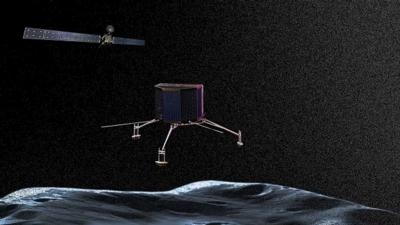After A Voyage Of 3.7 Billion Miles, Satellite And Lander Embark On Search For Primary Matter
The Rosetta comet chaser has arrived at its destination after flying for more than 10 years and travelling more than 3.7 billion miles. It is now ready to swivel into an orbit around the comet called 67P/Churyumov-Gerasimenko. The mission assigned to Rosetta and to the Philae lander that it is carrying, is to examine primary material from the nursery of the solar system 4.6 billion years ago over the next one and a half years.

The ESA satellite control center in Darmstadt, Germany, received news via radio signal that Rosetta had begun its approach. The space probe’s rendezvous with 67P took place some 248 million miles away from Earth. Rosetta will now accompany the comet on its journey around the sun and back again into the depths of our solar system. The Philae lander is scheduled to touch down on the comet’s surface in November in order to carry out measurements there.
“This is a great moment for the whole space community and also for ESA as well as our engineers and technicians at Airbus Defense and Space. Their creativity in the mission design and construction phase, as well as their expertise during the mission so far, have been key for Rosetta’s success,” said François Auque, Head of Space Systems. “Our robust spacecraft and the extraordinary performance of our hardware components, underline what is meant by ‘quality’.”
Since being launched from the spaceport in Kourou, French Guiana, on 2 March 2004, the Rosetta probe has flown three times past the Earth and once past Mars, in order to gain momentum, as well as past two asteroids (Steins 2008 and Lutetia 2010). For the most distant part of the journey, beyond the orbit of Jupiter, Rosetta was placed into “hibernation” for 31 months. It was awakened on 20 January this year in preparation for the final stage of its extraordinary journey to the 67P/Churyumov-Gerasimenko comet.
For planetary researchers, the Rosetta mission is akin to journeying back to the origins of the solar system. Unlike planets, whose rocks have been subjected to constant erosion and tectonics, the material inside the comet is the same as it was 4.6 billion years ago when it came into existence. Comets are therefore, in some ways, deep-frozen archives that scientists are now attempting to decipher.
While the hardware for Rosetta is designed to withstand temperatures as low as -270 degrees Celsius and a state of overwhelming “darkness”, the company currently is preparing the mercurial mission BepiColombo that has exactly the opposite characteristics. As of 2016, that mission will set out for the innermost planet of our solar system, Mercury, where temperatures of +350 degrees Celsius and solar radiation ten times more intense than on Earth will present new challenges for engineers and scientists. The spacecraft was developed and built by Airbus Defense and Space for the European Space Agency (ESA). Airbus Defense and Space will also play a key role in the upcoming ExoMars missions in 2016 and 2018, including the development of the ESA rover for the 2018 mission.
(Image provided by ESA)
 ANN's Daily Aero-Term (04.25.24): Airport Rotating Beacon
ANN's Daily Aero-Term (04.25.24): Airport Rotating Beacon ANN's Daily Aero-Linx (04.25.24)
ANN's Daily Aero-Linx (04.25.24) Klyde Morris (04.22.24)
Klyde Morris (04.22.24) Airborne 04.24.24: INTEGRAL E, Elixir USA, M700 RVSM
Airborne 04.24.24: INTEGRAL E, Elixir USA, M700 RVSM Airborne 04.22.24: Rotor X Worsens, Airport Fees 4 FNB?, USMC Drone Pilot
Airborne 04.22.24: Rotor X Worsens, Airport Fees 4 FNB?, USMC Drone Pilot



